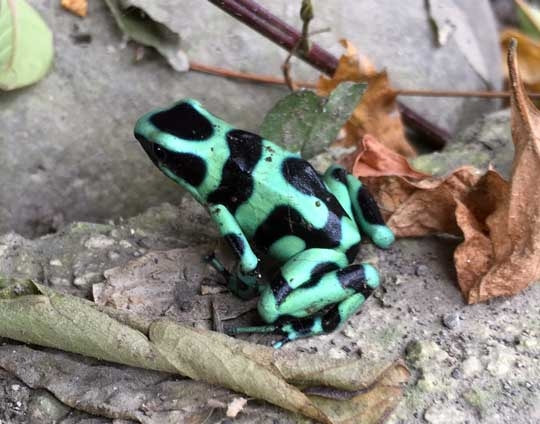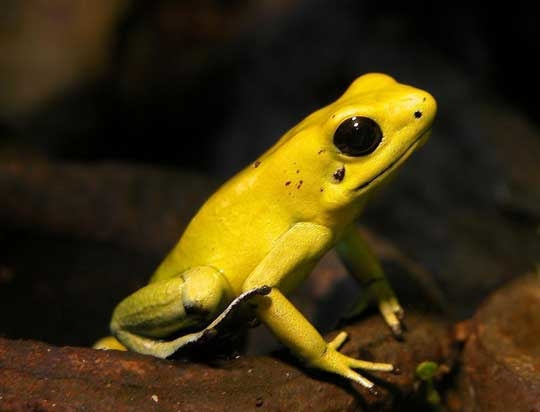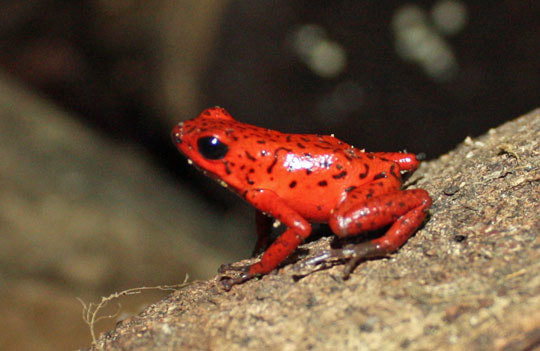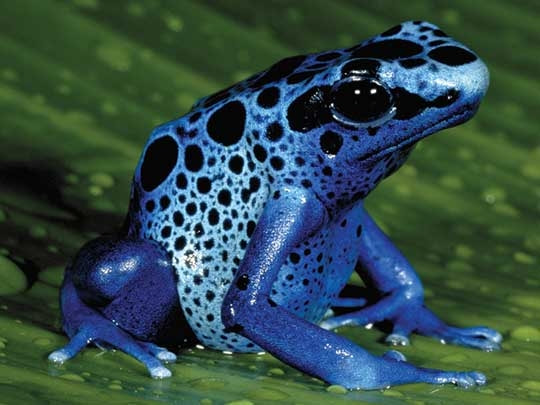|
You know how some animals have been given a name that makes them sound just awful? Like the gila monster (a lizard), or the hellbender (a salamander), or maybe the blobfish? It doesn't seem fair to the animal, does it? Well, today's awesome animal, the poison dart frog, is another creature with an undeserved negative name. But in spite of the name, they are arguably the most beautiful frogs in the world. So, what the heck is a Poison Dart Frog? Poison dart frogs are small but spectacular frogs in the family, Dendrobatidae. There are about 300 species living in Central America and South America. Yes, some of these frogs really are poisonous, and yes, native peoples use their poisons on the tips of their hunting blow darts (or at least they used to). Nevertheless, is it fair to name the entire group poison dart frogs? Out of about 300 species, only three of them are known to have been used for such a purpose. Many of the species aren't toxic at all or are only mildy toxic. The first poison dart frog I had a chance to see in the wild was when Trish and I were in Costa Rica in 2016. We had arrived at a nice ecolodge, and we were sitting on the patio, which was surrounded by gardens. I noticed a tiny green and black frog hopping through the vegetation nearby. It turned out to be this frog (which happens to actually be called the green and black poison dart frog): Amazing facts about Poison Dart Frogs Some poison dart frogs really are poisonous, but they are not venomous. Let's clear up a few important points. There are literally millions of animals that produce toxic chemicals. But that doesn't mean they're poisonous. By definition, in order to be poisonous, an animal must be toxic to eat. Poison dart frogs store toxins in glands beneath their skin. So if you eat one that is highly poisonous, you may be in serious trouble. For an animal to be venomous, it must have the ability to inject a toxic substance with fangs, a stinger, barbs, spurs, or something similar. Rattlesnakes and honeybees are venomous. Poison dart frogs do not bite and do not inject venom, so they are not venomous. They are poisonous. How poisonous are they? Well, most of them aren't particularly dangerous to humans. As I said above, only three types have been used for making poison hunting darts. But the most toxic of these, the golden poison frog, is one of the most toxic creatures on Earth. The poison from one individual is enough to kill 20,000 mice. Wow! How many humans would that be? Here's a golden poison frog: Poison dart frogs do not produce their poisons. Huh? It's true. Instead of producing the poisons in their own bodies, these frogs get the substances from the food they eat. They specialize on eating certain ants, beetles, mites, and millipedes that contain these toxins. This is why poison dart frogs that are raised in captivity have minimal levels of toxins. They don't have access to their natural, toxin-heavy food source. These frogs give their babies a toxin boost at a very young age. Recent studies have shown that mother frogs lay a number of unfertilized eggs, which happen to be laced with toxin. They feed these eggs to their young tadpoles, thus giving their babies a nice toxin boost to get them started. Isn't that sweet? Studies have shown that the brighter the frog is, the more toxic its poison is. Scientists actually used a spectrophotometer to measure the frogs' color. Those that were brighter and more conspicuous were more toxic. Below is the other poison dart frog we saw in Costa Rica, the strawberry poison dart frog: Okay, here's a question you may be wondering about. Since these frogs get their toxins by eating toxic prey (ants, mites, etc.), why aren't they poisoning themselves when they do this? As it turns out, it is a fairly simple mutation that makes them immune to the poison. If you want a more detailed explanation of this, check out this video. The way that natives used the frogs to get the poison onto their darts was rather gruesome. A study of the Emberá Indians of Columbia described the process. These people would catch a number of the frogs and place them in a hollow cane. When preparing darts, they would pull out a frog and "pass a pointed piece of wood down his throat, and out at one of his legs." Obviously, this would seriously agitate the frog, causing it to "sweat" out the poison on its back. They would then dip their arrows in the poison, and these arrows would remain effective for up to a year. Poison dart frogs evolved their extremely bright colors as a way to warn predators not to eat them. This is called Aposematism (a fancy word for "warning coloration"), and it is common in many different poisonous and venomous animals. The coral snake is a venomous example, and the monarch butterfly is a poisonous example. The bright black and white pattern of a skunk is another example, but skunks have a very different threat for predators to avoid. One more poison dart frog example, the blue poison dart frog: So, the Poison Dart Frog deserves a place in the B.T.C.A.H.O.F. (Beyond The Call Animal Hall of Fame). FUN FACT: The phrase beyond the call is a reduction of "above and beyond the call of duty," which probably originated in the American armed forces during World War I. In 1916, the services created a series of medals to honor acts of courage. The Medal of Honor would only be awarded for actions “above and beyond the call of duty." More recently, the phrase has become a way to describe almost anything that is excellent or well done. There are actually two shortened versions: "beyond the call" and "above and beyond." So, beyond the call is another way to say awesome! Photo Credits:
Green and Black Poison Dart Frog - Stan C. Smith Golden Poison Frog - Wikimedia Commons Strawberry Poison Dart Frog - Stan C. Smith Native with Blowgun - Wikimedia Commons Blue Poison Dart Frog - National Aquarium
1 Comment
Dixie Reed
10/31/2018 10:08:16 am
Just read your blog on poison dart frogs. They may be poisonous (or not), but they sure are beautiful. Since the poisonous ones can obviously excrete their poison (i.e., when tortured), could they be safely handled ?
Reply
Leave a Reply. |
Stan's Cogitations
Everyone needs a creative outlet. That's why I write. Archives
April 2024
|






 RSS Feed
RSS Feed